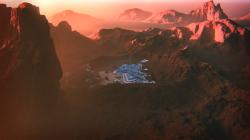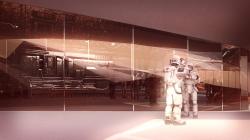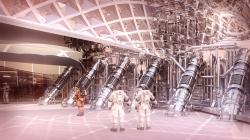Nova Project Planet Mars
The Nova Project – Planet Mars Research Center is conceived as the first stage of a long-term colonization mission on Mars. Located inside a natural crater, the project functions as a self-sufficient scientific station designed to ensure human survival under extreme environmental conditions. Its main goal is to establish a sustainable infrastructure capable of generating, storing, and recycling all the essential resources required for life and research on the Red Planet.
The architectural concept is based on a closed-loop system that integrates energy production, waste treatment, water recovery, food cultivation, and information management within a single, interdependent network. Each subsystem — from greenhouses and laboratories to energy modules and communication towers — operates autonomously yet remains interconnected, forming a continuous ecosystem of regeneration and balance.
The habitat’s location within the crater provides natural protection against intense Martian sandstorms and radiation. The structure adopts an organic, aerodynamic form that reduces the impact of strong winds and minimizes material erosion. Its skin, composed of adaptive panels and protective layers, regulates temperature while allowing the controlled entry of natural light — a fundamental element to sustain biological life and human well-being in such a hostile environment.
Energy is generated through a hybrid system combining solar panels and vertical wind turbines adapted to Martian atmospheric density. These energy sources feed both the research center and the life-support systems, maintaining autonomy for prolonged periods without Earth-based assistance. The internal circuits prioritize redundancy and energy efficiency to guarantee continuous operation under unpredictable climatic conditions.
At its core, the project includes communication arrays and satellite antennas that serve as the main hub for planetary coordination. This system enables real-time information exchange between different exploration bases, allowing the mapping of nearby territories and the planning of future urban strategies for long-term colonization.
The Nova Project embodies the principle of survival through adaptation. It represents an architecture that learns from the planet it inhabits — not one that imposes, but one that coexists. Its organic geometry responds not only to environmental demands but also to the psychological needs of its inhabitants, providing light, protection, and connection in an otherwise isolated world.
The project stands as a prototype for the first permanent human settlement on Mars — a synthesis of science, technology, and design serving the greater vision of transforming exploration into habitation, and habitation into the foundation of a new civilization.
2025
Project Type:
Scientific research and colonization base on Mars.
Prototype for autonomous habitat within an isolated crater environment.
Location:
Martian surface – Southern Hemisphere, crater-based topography providing natural protection from sandstorms and radiation exposure.
Structural System:
Modular pressurized shells composed of composite alloys (carbon fiber titanium) with flexible joints allowing expansion and contraction due to thermal gradients.
Secondary internal frame made of recycled Martian regolith, 3D-printed to form structural ribs and load-bearing vaults.
Exterior envelope with triple protective layers: thermal insulation, dust-repellent nanocoating, and radiation-absorption membrane.
Energy Systems:
Hybrid renewable system integrating solar photovoltaic fields (high-efficiency thin-film panels) and vertical-axis wind turbines adapted to low atmospheric density.
Hydrogen-based energy storage and microgrid distribution for continuous power flow.
Emergency backup system using kinetic turbines and biofuel cells for critical zones (labs, life support).
Environmental Control & Life Support:
Artificial atmosphere regulated through closed-loop oxygen generation and CO₂ reabsorption via algae bioreactors.
Temperature and humidity stabilized through phase-change thermal walls and internal geothermal exchangers.
Air purification via multi-stage ionization filters and nanofiber membranes ensuring sterile circulation.
Water Management:
Extraction from subsurface ice and atmospheric condensation.
Closed-loop purification plant using reverse osmosis and UV sterilization.
Reuse of gray water for agricultural and hydroponic systems.
Food Production:
Hydroponic and aeroponic greenhouses located in pressurized domes.
Artificial photosynthesis lighting system synchronized with circadian cycles.
Automatic nutrient control integrated with organic waste recycling.
Waste & Resource Recycling:
Comprehensive waste treatment: solid waste compression, plasma incineration, and mineral extraction for reuse.
Biological waste transformed into compost for greenhouse substrate.
Modular storage tanks for gases, liquids, and recycled materials.
Communication & Research Systems:
Planetary communication network composed of high-range antennas and orbital satellite link arrays.
Central research core equipped with AI-driven data management and remote telemetry.
External robotic units for geological exploration, terrain mapping, and construction support.
Lighting & Human Habitat Design:
Controlled skylight apertures and diffused LED systems simulate Earth-like light cycles to support circadian rhythm and psychological health.
Internal materials use light-reflective coatings and biophilic finishes for sensory comfort.
Acoustic absorption panels to mitigate reverberation within pressurized modules.
Sustainability & Adaptation:
Fully autonomous habitat designed for 3–5 years of independent operation without Earth resupply.
Expandable modular design with “plug-and-play” interfaces for future colonization nodes.
Environmental adaptability to dust storms, temperature drops (−60 °C), and low atmospheric pressure (≈600 Pa).
Total Area:
Approx. 12,000 m² (research habitat greenhouse energy communication modules).
Alumno: Victor Alfonso Montañez
Teacher: Arch. J. A. Fujimura
Teacher: Arch. Master's degree Daniel Williams





















